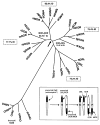Cloning and bioinformatics of amphibian mu, delta, kappa, and nociceptin opioid receptors expressed in brain tissue: evidence for opioid receptor divergence in mammals
- PMID: 17452077
- PMCID: PMC3075437
- DOI: 10.1016/j.neulet.2007.04.014
Cloning and bioinformatics of amphibian mu, delta, kappa, and nociceptin opioid receptors expressed in brain tissue: evidence for opioid receptor divergence in mammals
Abstract
Opioid agonists produce analgesia in humans and other mammals by binding to three distinct types of G protein-coupled receptors; mu (MOR), delta (DOR), and kappa (KOR) opioid receptors. A fourth member of the opioid receptor family is the nociceptin or orphanin FQ receptor (ORL), however the role of the ORL receptor in analgesia is less clear. In the Northern grass frog, Rana pipiens, systemic and central administration of morphine and selective MOR, DOR, and KOR agonists produced dose-dependent antinociceptive effects blocked by the general opioid antagonist, naltrexone. The present study reports on the sequence, expression, and bioinformatics of four opioid receptor cDNAs cloned from Rana pipiens; rpMOR, rpDOR, rpKOR, and rpORL. These were the first opioid receptors cloned from a species of Class Amphibia, are selectively expressed in brain tissue, and show 70-84% identity to their homologous mammalian opioid receptors. Comparisons within species showed that MOR, DOR, and KOR proteins are significantly less divergent in earlier-evolved vertebrates compared to humans and other mammals. Among the four types of opioid receptors, MOR proteins show the least sequence variation among the six vertebrate species. Additionally, phylogenetic analysis supports the hypothesis that the family of opioid receptor proteins are coded by four genes that arose from two gene duplications of a single ancestral opioid receptor gene.
Figures


Similar articles
-
The evolution of vertebrate opioid receptors.Front Biosci (Landmark Ed). 2009 Jan 1;14(4):1247-69. doi: 10.2741/3306. Front Biosci (Landmark Ed). 2009. PMID: 19273128 Free PMC article. Review.
-
Bioinformatics and evolution of vertebrate nociceptin and opioid receptors.Vitam Horm. 2015;97:57-94. doi: 10.1016/bs.vh.2014.10.002. Epub 2015 Jan 20. Vitam Horm. 2015. PMID: 25677768 Review.
-
Opioid research in amphibians: an alternative pain model yielding insights on the evolution of opioid receptors.Brain Res Brain Res Rev. 2004 Oct;46(2):204-15. doi: 10.1016/j.brainresrev.2004.07.003. Brain Res Brain Res Rev. 2004. PMID: 15464208 Free PMC article. Review.
-
Cloning, heterologous expression and pharmacological characterization of a kappa opioid receptor from the brain of the rough-skinned newt, Taricha granulosa.J Mol Endocrinol. 2005 Jun;34(3):809-23. doi: 10.1677/jme.1.01711. J Mol Endocrinol. 2005. PMID: 15956349
-
Cloning, pharmacological characterization and tissue distribution of an ORL1 opioid receptor from an amphibian, the rough-skinned newt Taricha granulosa.J Mol Endocrinol. 2005 Feb;34(1):247-56. doi: 10.1677/jme.1.01687. J Mol Endocrinol. 2005. PMID: 15691892
Cited by
-
Current research on opioid receptor function.Curr Drug Targets. 2012 Feb;13(2):230-46. doi: 10.2174/138945012799201612. Curr Drug Targets. 2012. PMID: 22204322 Free PMC article. Review.
-
Single Amino Acid Variation Underlies Species-Specific Sensitivity to Amphibian Skin-Derived Opioid-like Peptides.Chem Biol. 2015 Jun 18;22(6):764-75. doi: 10.1016/j.chembiol.2015.05.012. Chem Biol. 2015. PMID: 26091169 Free PMC article.
-
Nociceptin produces antinociception after spinal administration in amphibians.Pharmacol Biochem Behav. 2009 Jan;91(3):436-40. doi: 10.1016/j.pbb.2008.08.022. Epub 2008 Sep 5. Pharmacol Biochem Behav. 2009. PMID: 18804120 Free PMC article.
-
Effects of sciatic nerve transection on ultrastructure, NADPH-diaphorase reaction and serotonin-, tyrosine hydroxylase-, c-Fos-, glucose transporter 1- and 3-like immunoreactivities in frog dorsal root ganglion.Braz J Med Biol Res. 2013 Jun;46(6):513-20. doi: 10.1590/1414-431X20132853. Epub 2013 May 24. Braz J Med Biol Res. 2013. PMID: 23739744 Free PMC article.
-
Analgesia in amphibians: preclinical studies and clinical applications.Vet Clin North Am Exot Anim Pract. 2011 Jan;14(1):33-44. doi: 10.1016/j.cvex.2010.09.007. Vet Clin North Am Exot Anim Pract. 2011. PMID: 21074701 Free PMC article. Review.
References
-
- Altschul SF, Gish W, Miller W, Myers EW, Lipman DJ. Basic local alignment search tool. J Mol Biol. 1990;215:403–410. - PubMed
-
- Barrallo A, González-Sarmiento R, Porteros A, Gracia-Isídoro M, Rodríguez RE. Cloning. molecular characterization, and distribution of a gene homologous to δ opioid receptor from zebrafish (Danio rerio) Biochem Biophys Res Commun. 1998;245:544–548. - PubMed
-
- Bradford CS, Walthers EA, Stanley DJ, Baugh MM, Moore FL. Delta and mu opioid receptors from the brain of a urodele amphibian, the rough-skinned newt, Taricha granulosa: cloning, heterologous expression, and pharmacological characterization. Gen Comp Endocrinol. 2006;146:275–290. - PubMed
-
- Darlison MG, Greten FR, Harvey RJ, Kreienkamp H, Stuhmer T, Zwiers H, Lederis K, Richter D. Opioid receptors from a lower vertebrate (Catostomus commersoni): sequence, pharmacology, coupling to a G-protein-gated inward-rectifying potassium channel (GIRK1), and evolution. Proc Natl Acad Sci USA. 1997;94:8214–8219. - PMC - PubMed
-
- Dorus S, Vallender EJ, Evans PD, Anderson JR, Gilbert SL, Mahowald M, Wyckoff GJ, Malcom CM, Lahn BT. Accelerated evolution of nervous system genes in the origin of Homo sapiens. Cell. 2004;119:1027–1040. - PubMed
Publication types
MeSH terms
Substances
Grants and funding
LinkOut - more resources
Full Text Sources
Research Materials

